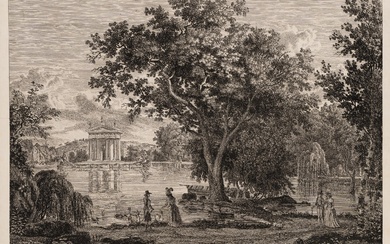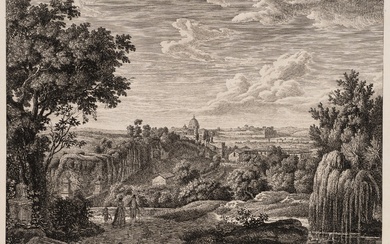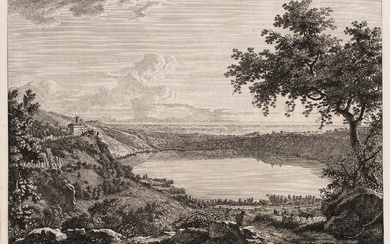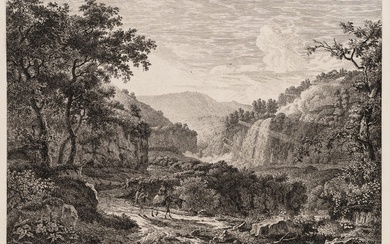A.DIES(*1755), Villa of Brutus in Tivoli, 1794
Albert Christoph Dies (1755 Hannover - 1822 Wien), The Villa of Brutus in Tivoli, 1794, Etching
Technique: Etching on paper
Size: 9 2/3 x 13 3/4 in, Additional Sizes: Papier: 39,1 x 49,3 cm, Plate: 11 x 14 3/4 in
Inscription: in the plate signed, dated and inscribed: "A. C. Dies fece Roma 1794" and inscribed: "Avanzi della Villa di M. Bruto a Tivoli"
Condition: Very good condition. Slightly discoloured and rubbed on the edge. A little wavy in the middle. Occasionally, short, restored marginal tears are visible.
Description: The Hannover-born landscape painter Albrecht Christoph Dies is often referred to as an autodidact who turned to painting without any academic training as an artist. In 1775, at the age of 20, after a rudimentary education with an unknown painter, he decided to "spontaneously" (Schmid 1998, p.162) expand his wanderings in the German-speaking area to Italy. In the same year, he settled in Rome and worked as a colourist in the well-known Roman veduta workshops of Piranesi, Durcos and Volpato. Occasional works such as copying popular artists trained him further in painting and sharpened his eye for the landscape paintings of Jacob Philipp Hackert. His idea of realistic landscape portraits was also pursued by Dies in the Etchings shown here. The picture detail was deliberately chosen in a picturesque way, since it was above all important to the artist to precisely reproduce landscape and architecture, i.e. almost to portray them. The romantic and picturesque atmosphere radiated by the barrel vaults of Brutus' Villa in Tivoli, overgrown by nature, as well as by the enormous spray cascades of the waterfalls at Villa Gregoriana near Tivoli, does not in either case contradict the artist's actual gaze. Rather, the special attraction of these representations lies in the fact that they were drawn from nature on site and transferred to the copper plate by Dies himself. Only the staffage of animals and humans, which give the pictures their liveliness, were freely invented and purposefully used. Of particular interest are the depictions of botany and geological events. Shaped by the rise of the natural sciences at the end of the 18th century, the visual artists also developed an awareness for the accurate reproduction of animals, plants and rocks as well as the aesthetics of the natural reproduction. Marcus Brutus was a lawyer in Rome. His villa, mentioned by Cicero in the 2nd book of "De Oratore", is on the road to San Gregorio on the southern slope of Tivoli.
Keywords: Classicism, Architecture, Botany, Landscape, Animals, Cattle, Sheep, Ruin, Antiquity, Italy, Nature, Architecture
__________
Albert Christoph Dies (1755 Hannover - 1822 Wien), Die Villa des Brutus in Tivoli, 1794, Radierung
Technik: Radierung auf Papier
Größe: 24,5 x 35 cm, Weitere Größen: Papier: 39,1 x 49,3 cm, Plattenmaß: 27,7 x 37,4 cm
Bezeichnung: in der Platte signiert, datiert und bezeichnet: "A. C. Dies fece Roma 1794" und bezeichnet: "Avanzi della Villa di M. Bruto a Tivoli"
Zustand: Sehr guter Zustand. Auf dem Rand schwach verfärbt und berieben. Mittig etwas wellig. Vereinzelt sind kurze, restaurierte Randeinrisse sichtbar.
Beschreibung: Der aus Hannover stammende Landschaftsmaler Albrecht Christoph Dies wird oft als Autodidakt bezeichnet, der sich ohne akademische Künstlerausbildung der Malerei zuwandte. 1775 beschloss er, im Alter von 20 Jahren, nach einer rudimentären Ausbildung bei einem unbekannten Maler, offenbar „spontan“ (Schmid 1998, S.162) seine Wanderschaft im deutschsprachigen Gebiet nach Italien auszuweiten. Noch im selben Jahr ließ er sich in Rom nieder und verdingte sich mit dem Kolorieren von Stichen in den namhaften römischen Vedutenwerkstätten Piranesi sowie Durcos und Volpato. Gelegenheitsarbeiten wie das Kopieren beliebter Künstler schulten ihn weiter in der Malerei und schärften sein Auge für die Landschaftsbilder von Jacob Philipp Hackert. Dessen Vorstellung von realistischen Landschaftsporträts verfolgte Dies auch in den hier gezeigten Radierungen. Den Bildausschnitt bewusst pittoresk gewählt, war es dem Künstler doch vor allen Dingen wichtig, Landschaft und Architektur präzise nachzubilden, also beinahe zu porträtieren. Die romantische und malerische Stimmung, die sowohl die von der Natur überwucherten Tonnengewölbe der Villa des Brutus in Tivoli, als auch die gewaltigen, gischtsprühenden Kaskaden der Wasserfälle an der Villa Gregoriana bei Tivoli ausstrahlen, steht also in keinem der beiden Fälle entgegen dem tatsächlichen Blick des Künstlers. Vielmehr liegt der besondere Reiz dieser Darstellungen darin, dass sie vor Ort nach der Natur gezeichnet und von Dies selbst auf die Kupferplatte übertragen wurden. Lediglich die Staffage aus Tieren und Menschen, die den Bildern ihre Lebendigkeit geben, sind frei erfunden und gezielt eingesetzt worden. Von besonderem Interesse sind nicht zuletzt die Darstellungen der Botanik und der geologischen Begebenheiten. Durch den Aufschwung der Naturwissenschaften zum Ende des 18. Jahrhunderts geprägt, entwickelten auch die bildenden Künstler ein Bewusstsein für die akkurate Wiedergabe von Tieren, Pflanzen und Gestein sowie die Ästhetik des natürlich Nachgebildeten. Marcus Brutus war Jurist in Rom. Seine Villa, von Cicero im 2. Buch von "De Oratore" erwähnt, liegt an der Straße nach San Gregorio am Südhang von Tivoli.
Schlagworte: Klassizismus, Architektur, Botanik, Landschaft, Tiere, Rinder, Schafe, Ruine, Antike, Italien, Natur
Dimensions: 48.8 x 38.7 cm
Condition Report: Very good condition. Slightly discoloured and rubbed on the edge. A little wavy in the middle. Occasionally, short, restored marginal tears are visible. | Sehr guter Zustand. Auf dem Rand schwach verfärbt und berieben. Mittig etwas wellig. Vereinzelt sind kurze, restaurierte Randeinrisse sichtbar.
View it on
Estimate
Time, Location
Auction House
Albert Christoph Dies (1755 Hannover - 1822 Wien), The Villa of Brutus in Tivoli, 1794, Etching
Technique: Etching on paper
Size: 9 2/3 x 13 3/4 in, Additional Sizes: Papier: 39,1 x 49,3 cm, Plate: 11 x 14 3/4 in
Inscription: in the plate signed, dated and inscribed: "A. C. Dies fece Roma 1794" and inscribed: "Avanzi della Villa di M. Bruto a Tivoli"
Condition: Very good condition. Slightly discoloured and rubbed on the edge. A little wavy in the middle. Occasionally, short, restored marginal tears are visible.
Description: The Hannover-born landscape painter Albrecht Christoph Dies is often referred to as an autodidact who turned to painting without any academic training as an artist. In 1775, at the age of 20, after a rudimentary education with an unknown painter, he decided to "spontaneously" (Schmid 1998, p.162) expand his wanderings in the German-speaking area to Italy. In the same year, he settled in Rome and worked as a colourist in the well-known Roman veduta workshops of Piranesi, Durcos and Volpato. Occasional works such as copying popular artists trained him further in painting and sharpened his eye for the landscape paintings of Jacob Philipp Hackert. His idea of realistic landscape portraits was also pursued by Dies in the Etchings shown here. The picture detail was deliberately chosen in a picturesque way, since it was above all important to the artist to precisely reproduce landscape and architecture, i.e. almost to portray them. The romantic and picturesque atmosphere radiated by the barrel vaults of Brutus' Villa in Tivoli, overgrown by nature, as well as by the enormous spray cascades of the waterfalls at Villa Gregoriana near Tivoli, does not in either case contradict the artist's actual gaze. Rather, the special attraction of these representations lies in the fact that they were drawn from nature on site and transferred to the copper plate by Dies himself. Only the staffage of animals and humans, which give the pictures their liveliness, were freely invented and purposefully used. Of particular interest are the depictions of botany and geological events. Shaped by the rise of the natural sciences at the end of the 18th century, the visual artists also developed an awareness for the accurate reproduction of animals, plants and rocks as well as the aesthetics of the natural reproduction. Marcus Brutus was a lawyer in Rome. His villa, mentioned by Cicero in the 2nd book of "De Oratore", is on the road to San Gregorio on the southern slope of Tivoli.
Keywords: Classicism, Architecture, Botany, Landscape, Animals, Cattle, Sheep, Ruin, Antiquity, Italy, Nature, Architecture
__________
Albert Christoph Dies (1755 Hannover - 1822 Wien), Die Villa des Brutus in Tivoli, 1794, Radierung
Technik: Radierung auf Papier
Größe: 24,5 x 35 cm, Weitere Größen: Papier: 39,1 x 49,3 cm, Plattenmaß: 27,7 x 37,4 cm
Bezeichnung: in der Platte signiert, datiert und bezeichnet: "A. C. Dies fece Roma 1794" und bezeichnet: "Avanzi della Villa di M. Bruto a Tivoli"
Zustand: Sehr guter Zustand. Auf dem Rand schwach verfärbt und berieben. Mittig etwas wellig. Vereinzelt sind kurze, restaurierte Randeinrisse sichtbar.
Beschreibung: Der aus Hannover stammende Landschaftsmaler Albrecht Christoph Dies wird oft als Autodidakt bezeichnet, der sich ohne akademische Künstlerausbildung der Malerei zuwandte. 1775 beschloss er, im Alter von 20 Jahren, nach einer rudimentären Ausbildung bei einem unbekannten Maler, offenbar „spontan“ (Schmid 1998, S.162) seine Wanderschaft im deutschsprachigen Gebiet nach Italien auszuweiten. Noch im selben Jahr ließ er sich in Rom nieder und verdingte sich mit dem Kolorieren von Stichen in den namhaften römischen Vedutenwerkstätten Piranesi sowie Durcos und Volpato. Gelegenheitsarbeiten wie das Kopieren beliebter Künstler schulten ihn weiter in der Malerei und schärften sein Auge für die Landschaftsbilder von Jacob Philipp Hackert. Dessen Vorstellung von realistischen Landschaftsporträts verfolgte Dies auch in den hier gezeigten Radierungen. Den Bildausschnitt bewusst pittoresk gewählt, war es dem Künstler doch vor allen Dingen wichtig, Landschaft und Architektur präzise nachzubilden, also beinahe zu porträtieren. Die romantische und malerische Stimmung, die sowohl die von der Natur überwucherten Tonnengewölbe der Villa des Brutus in Tivoli, als auch die gewaltigen, gischtsprühenden Kaskaden der Wasserfälle an der Villa Gregoriana bei Tivoli ausstrahlen, steht also in keinem der beiden Fälle entgegen dem tatsächlichen Blick des Künstlers. Vielmehr liegt der besondere Reiz dieser Darstellungen darin, dass sie vor Ort nach der Natur gezeichnet und von Dies selbst auf die Kupferplatte übertragen wurden. Lediglich die Staffage aus Tieren und Menschen, die den Bildern ihre Lebendigkeit geben, sind frei erfunden und gezielt eingesetzt worden. Von besonderem Interesse sind nicht zuletzt die Darstellungen der Botanik und der geologischen Begebenheiten. Durch den Aufschwung der Naturwissenschaften zum Ende des 18. Jahrhunderts geprägt, entwickelten auch die bildenden Künstler ein Bewusstsein für die akkurate Wiedergabe von Tieren, Pflanzen und Gestein sowie die Ästhetik des natürlich Nachgebildeten. Marcus Brutus war Jurist in Rom. Seine Villa, von Cicero im 2. Buch von "De Oratore" erwähnt, liegt an der Straße nach San Gregorio am Südhang von Tivoli.
Schlagworte: Klassizismus, Architektur, Botanik, Landschaft, Tiere, Rinder, Schafe, Ruine, Antike, Italien, Natur
Dimensions: 48.8 x 38.7 cm
Condition Report: Very good condition. Slightly discoloured and rubbed on the edge. A little wavy in the middle. Occasionally, short, restored marginal tears are visible. | Sehr guter Zustand. Auf dem Rand schwach verfärbt und berieben. Mittig etwas wellig. Vereinzelt sind kurze, restaurierte Randeinrisse sichtbar.







